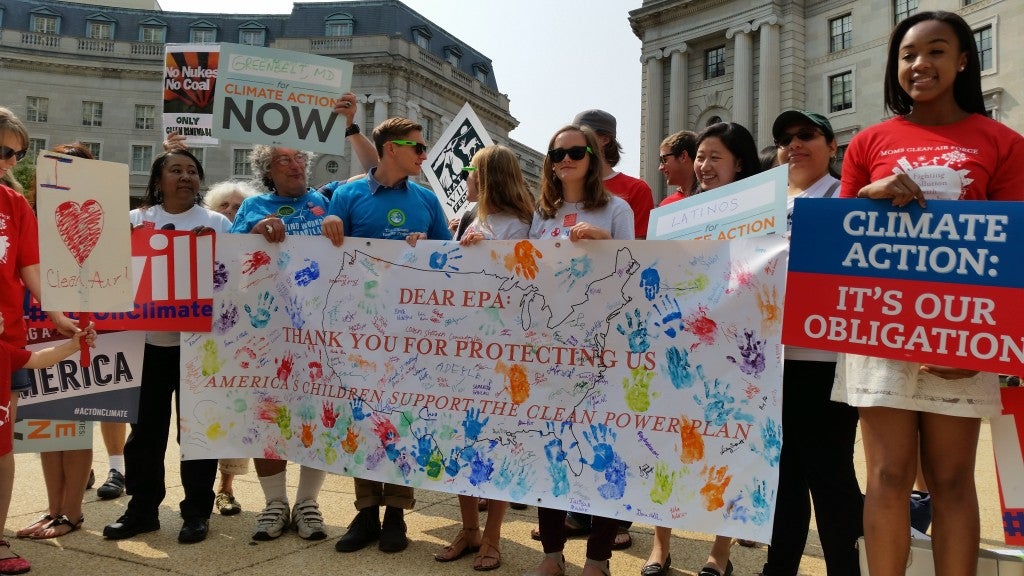The Environmental Protection Agency (EPA) will finalize rules establishing the nation’s first limits on carbon pollution from the power sector – the largest source of greenhouse gas emissions in the United States – by mid-summer of this year.
This timetable will allow EPA to carefully consider and respond to the approximately four million public comments it has received on almost every aspect of these vital and common-sense standards, which were proposed in draft form last summer as the Clean Power Plan.
Unfortunately, several states and a major coal producer have attempted to short-circuit this process by filing highly unusual legal challenges to these proposed standards. The challenges were filed in the U.S. Court of Appeals for the D.C. Circuit in two related cases, Murray Energy Corporation v. EPA (Nos. 14-1112 & 14-1151) and West Virginia v. EPA (No. 14-1146).
EDF — along with other environmental groups, a coalition of states, and a major power company — participated in these suits in support of EPA, and briefs were filed in both cases this week. (Read our brief in Murray Energy here and our brief in West Virginia here).
These lawsuits are untimely, legally unfounded, and seek to undermine a critically important democratic process.
One of the bedrock principles of administrative law is that standards developed by federal agencies go through a procedure whereby draft standards are published, the public has an opportunity to comment, and agencies review and respond to those comments in the final standards — all before legal challenges to those rules can be filed.
This process ensures that the public has a meaningful chance to weigh in on agency actions. It also helps agencies themselves ensure their decisions are well-informed and firmly grounded in law and science. In fact, proposed rules often undergo substantial changes as a result of the comment process. The rule against judicial review of proposed rules respects the importance of this process, and keeps courts and agencies from wasting valuable time and judicial resources on litigation over rules that may change as a result of public comments.
Disregarding this basic principle, the petitioners in these two cases argue that the proposed Clean Power Plan is unlawful – and demand that the court set the proposed rule aside before EPA has even finished its review of comments, much less issued a final rule.
But this fundamental jurisdictional obstacle is only the start of the problems with the petitioners’ case, which rests on an implausible reading of the Clean Air Act that would undermine the very health protections Congress sought to establish there.
EPA’s Clean Power Plan is authorized by section 111(d) of the Act, which requires EPA to administer a process by which states submit plans to regulate certain pollutants from existing sources of harmful air pollution. When enacted in 1970, section 111(d) clearly required that states establish such standards for any pollutant except those regulated under section 108 of the Clean Air Act (which addresses national air quality standards) and section 112 (which applies to acutely toxic “hazardous air pollutants” or HAPs).
For more than forty years, section 111(d) has been understood to serve a vital “gap-filling” role in the Clean Air Act – ensuring the protection of human health and welfare from harmful air pollution from existing sources, where that pollution is not adequately regulated under other provisions of the Clean Air Act.
Ignoring that sensible and long-standing framework, the petitioners in these cases have advanced an unusual theory — that EPA is barred from regulating carbon pollution at all under section 111(d) of the Clean Air Act because the Agency is already regulating different pollutants from the power sector (mercury and other air toxics) under section 112 of the Clean Air Act.
As EPA explained in its brief in West Virginia, this theory amounts to a “pick your poison” approach to the Clean Air Act – arbitrarily limiting EPA to regulating either HAPs like mercury (under section 112) or non-HAPs like carbon pollution (under section 111(d)) for any given source, but not both.
The petitioners’ interpretation not only defies logic and the basic structure of our nation’s clean air laws, it also stands in sharp contrast to arguments that industry itself made to the Supreme Court in the case of American Electric Power v. Connecticut (2011).
There, the Court specifically found that section 111(d) “speaks directly” to the problem of carbon pollution from the power sector, and held that EPA’s authority to regulate carbon pollution under section 111(d) displaces federal common law.
In oral argument in American Electric Power, attorneys for some of the country’s largest power companies told the Court in no uncertain terms that EPA does have authority to regulate carbon dioxide under section 111(d):
“We believe that the EPA can consider, as it’s undertaking to do, regulating existing nonmodified sources under section 111 of the Clean Air Act, and that’s the process that’s engaged in now… Obviously, at the close of that process there could be APA challenges on a variety of grounds, but we do believe that they have the authority to consider standards under section 111.”
Four years later, petitioners now claim that EPA is required to adopt their interpretation as a result of changes made to the text of section 111(d) as part of the 1990 Clean Air Act Amendments.
In 1990, in an effort to update a cross-reference to the hazardous air pollution program under section 112, the Senate and House each passed technical amendments making minor changes to the same language in section 111(d). Congress then enacted, and the President signed into law, both amendments to the statute.
Even petitioners do not contest that the language of the Senate Amendment clearly preserves EPA’s long-standing authority to regulate carbon pollution under section 111(d) (as well as other pollutants not regulated under sections 108 or 112). However, petitioners have seized on the House amendment, which amended section 111(d) to require that EPA regulate “any pollutant” which is not “emitted from a source category which is regulated under [section 112].” This language, they claim, prevents EPA from regulating carbon dioxide from existing power plants —because power plants are subject to emission standards for mercury, acid gases, and other HAPs under section 112.
This argument finds no support in the Act’s text, structure, or legislative history.
First, the petitioners’ theory would radically change the structure of the Clean Air Act in a way that Congress could never have intended. Under the Petitioners’ theory, section 111(d) would not apply to any pollutant, no matter how harmful, that is emitted by the dozens of industrial source types regulated under section 112 of the Clean Air Act. Significant categories of harmful pollution, not limited to carbon dioxide, would be placed beyond the scope of regulation under the Clean Air Act. In all of the extensive debate, committee reports, and other legislative history that led up to the enactment of the 1990 Clean Air Act amendments, there is not a shred of evidence that Congress intended to create loopholes in section 111(d) as the petitioners claim.
Second, the 1990 amendments include a provision stating that standards under section 112 must not be “interpreted, construed or applied to diminish or replace” more stringent requirements under section 111 – a strong indication that Congress intended for section 112 to work seamlessly with, not displace, section 111(d).
Third, the petitioners’ theory is completely at odds with the purpose of the 1990 Amendments, which strengthened the Act in numerous ways in order to ensure that harmful air pollution was being effectively addressed.
Petitioners also urge the court to disregard what Congress actually did by ignoring the Senate amendment, which even petitioners agree clearly preserves EPA’s authority to regulate carbon pollution under section 111(d). But the Senate amendment was passed by both houses of Congress and signed into law by the President. As the law of the land, the Senate Amendment cannot be cast aside.
Instead, the petitioners emphasize a strained interpretation of the House Amendment that is not only unreasonable on its face and inconsistent with the Supreme Court’s opinion in AEP, as described above, but is contrary to all of the actions taken by every administration in the twenty-five years since the 1990 amendments were enacted.
As documented in a compelling brief filed by NYU’s Institute for Policy Integrity, EPA has adopted the view that section 111(d) applies to any pollutant not regulated under section 112 or section 108 in multiple rulemakings since 1990 — not just in the Obama Administration, but also the George W. Bush Administration, the Clinton Administration, and the Administration of George H.W. Bush, who actually signed the 1990 amendments. This long record shows that the House amendment is most reasonably interpreted to preserve the historic “gap-filling” role of section 111(d).
It is regrettable that petitioners have resorted to premature litigation rather than allow the administrative process to run its course.
EPA undoubtedly possesses the authority to limit carbon pollution from existing power plants under section 111(d) of the Clean Air Act. That’s good news for families and communities that are afflicted by mercury and carbon pollution from fossil fuel power plants — the nation’s single largest source of both health-harming contaminants. Congress did not intend for our children to have to “pick their poisons,” but instead created a seamless framework – which Republican and Democratic administrations alike have long carried out — to safeguard our children’s health from all harmful air pollution.
Cecilia Segal, a legal intern at EDF, helped to prepare this post.















